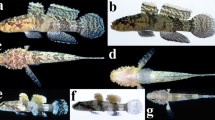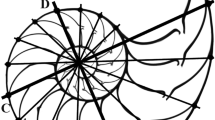Abstract
This study was conducted to clarify the distribution and morphology of free neuromasts during the development of half-smooth tongue sole (Cynoglossus semilaevis) using scanning electron microscopy. During development, (1) the apical surface of free neuromasts changed in shape from a circle to a four-point star; (2) the external structure changed from being level with the epidermis to papilla-like above the level of the epidermis; (3) the neuromast cupula changed from cylindrical to blade-shaped; (4) the free neuromasts went from occurring singly to being in clusters of a few single organs; (5) the arrangement changed from a linear array to no discernable pattern; (6) there was a significant increase in the number of free neuromasts after metamorphosis. In adult C. semilaevis, free neuromasts were only observed on the abocular side of the head. Thus, there were more free neuromasts located on the abocular side of the head with a higher concentration around the anterior nostril and mouth, which may have a mechanical sensory function to help locate food as an adaptation to a benthic mode of life.
Similar content being viewed by others
References
Appelbaum S, Schemmel C. 1983. Dermal sense organs and their significance in the feeding behavior of the common sole Solea vulgaris. Mar. Ecol. Prog. Ser., 13: 29–36.
Blaxter J H S. 1987. Structure and development of the lateral line. Biol. Rev., 62 (4): 471–514.
De Groot S J. 1971. On the interrelationships between morphology of the alimentary tract, food and feeding behaviour in flatfishes (Pisces: Pleuronectiformes). Neth. J. Sea Res., 5 (2): 121–196.
Dijkgraaf S. 1963. The functioning and significance of the lateral-line organs. Biol. Rev., 38 (1): 51–105.
Faucher K, Dutto G, Covès D, Aubert A, Lagardère J P. 2006. No efficiency of the lateral system on nocturnal feeding in the European sea bass (Dicentrarchus labrax L.). Aquaculture, 252 (2-4): 462–475.
Harris G G, van Bergeijk W A. 1962. Evidence that the lateral line organ responds to water displacements. J. Acoust. Soc. Am., 34 (5): 733.
Harvey R, Blaxter J H S, Hoyt R D. 1992. Development of superficial and lateral line neuromasts in larvae and juveniles of plaice (Pleuronectes platessa) and sole (Solea solea). J. Mar. Biol. Assoc. UK., 72 (3): 651–668.
Iwai T. 1965. Notes on the cupulae of free neuromasts in larvae of the goldfish. Copeia, 1965 (3): 379.
Kawamura G, Ishida K. 1995. Changes in sense organ morphology and behaviour with growth in the flounder Paralichthys olivaceus. N ippon. Suisan. G akk., 51 (2): 155–165.
Kawamura G, Masaru S, Tezuka N, Koiso M, Jinbo T, Namba K. 2003. Morphogenesis of sense organs in the bluefin tuna Thunnus orientalis. I n: Brawman H I, Skiftesvik A B eds. The Big Fish Bang. Proceedings of the 26th Annual Larval Fish Conference. Bergen. p.123–135.
Kroese A B A, van Netten S M. 1989. Sensory transduction in lateral line hair cells. In: Coombs S, Görner P, Münz H eds. The Mechanosensory Lateral Line-Neurobiology and Evolution. Springer-Verlag, New York, USA. p.265–284.
Livingston M E. 1987. Morphological and sensory specializations of five New Zealand flatfish species, in relation to feeding behaviour. J. Fish. Biol., 31 (6): 775–795.
Ma A J, Liu X Z, Xu Y J, Liang Y, Zhuang Z M. 2006. Feeding rhythm and growth of the tongue sole, Cynoglossus semilaevis Günther, during its early life stages. Aqu. Res., 37 (6): 586–593.
Ma A J, Wang X A, Zhuang Z M. 2007a. Lateral-line sense organs and dermal surface structures of the tongue sole Cynoglossus semilaevis. Acta Zoolog. Sin., 53 (6): 1113–1121. (in Chinese with English abstract)
Ma A J, Wang X A, Zhuang Z M, Zhang X M, Zhang L J. 2007b. Structure of retina and visual characteristics of the half-smooth tongue-sole Cynoglossus semilaevis Günter. Acta Zoolog. Sin., 53 (2): 354–363. (in Chinese with English abstract)
Marshall N J. 1996. The lateral line systems of three deep-sea fish. J. Fish. Biol., 49 (S1): 239–258.
Mukai Y. 2006. Role of free neuromasts in larval feeding of willow shiner Gnathopogon elongatus caerulescens Teleostei, Cyprinidae. Fish. Sci., 72 (4): 705–709.
Mukai Y, Kobayashi H. 1995. Development of free neuromasts with special reference to sensory polarity in larvae of the willow shiner, Gnathopogon elongatus caerulescens (Teleostei, Cyprinidae). Zoolog. Sci., 12 (1): 125–131.
Mukai Y, Kobayashi H, Yoshikawa H. 1992. Development of free and canal neuromasts and their directions of maximum sensitivity in the larvae of ayu, Plecoglossus altivelis. Jpn. J. Ichthyol., 38 (4): 411–417.
Münz H. 1985. Single unit activity in the peripheral lateral line system of the cichlid fish Sarotherodon niloticus L. J. Comp. Physiol. A., 157 (5): 555–568.
Münz H. 1989. Functional organization of the lateral line periphery. In: Coombs S, Görner P, Münz H eds. The Mechanosensory Lateral Line -Neurobiology and Evolution. Springer-Verlag, New York, USA. p.285–297.
Neave D A. 1986. The development of the lateral line system in plaice (Pleuronectes platessa) and turbot (Scophthalmus maximus). J. Mar. Biol. Assoc. UK., 66 (3): 683–693.
Northcutt R G. 1989. The phylogenetic distribution and innervation of craniate mechanoreceptive lateral lines. In: Coombs S, Görner P, Münz H eds. The Mechanosensory Lateral Line. Springer, New York. p.17–78.
Roper D S. 1981. Superficial neuromasts of the flatfish Peltorhamphus novaezeelandiae (Günther). J. Fish. Biol., 18 (6): 753–758.
Song J K, Northcutt R G. 1991a. Morphology, distribution and innervation of the lateral-line receptors of the Florida gar, Lepisosteus platyrhincus. Brain. Behav. Evolut., 37 (1): 10–37.
Song J K, Northcutt R G. 1991b. The primary projections of the lateral-line nerves of the Florida gar, Lepisosteus platyrhincus. Brain. Behav. Evolut., 37 (1): 38–63.
Author information
Authors and Affiliations
Corresponding author
Additional information
Supported by the earmarked fund for Modern Agro-Industry Technology Research System (CARS-50-G01), the Fund for Outstanding Talents and Innovative Team of Agricultural Scientific Research, the Qingdao Natural Science Foundation (No. 12-1-4-12-(1)-jch), and the Research Fund for the Postgraduate of Shanghai Ocean University (No. A1-0209-14-0900-5)
MA Aijun and SHANG Xiaomei contributed equally to this work.
Rights and permissions
About this article
Cite this article
Ma, A., Shang, X., Zhou, Z. et al. Morphological variation and distribution of free neuromasts during half-smooth tongue sole Cynoglossus semilaevis ontogeny. Chin. J. Ocean. Limnol. 35, 244–250 (2017). https://doi.org/10.1007/s00343-016-5227-6
Received:
Accepted:
Published:
Issue Date:
DOI: https://doi.org/10.1007/s00343-016-5227-6




